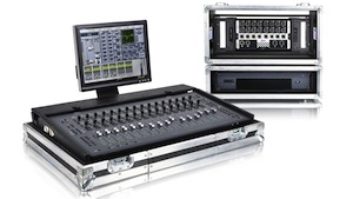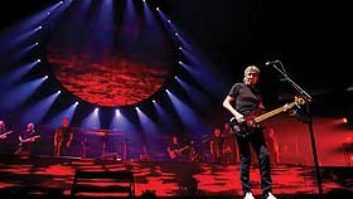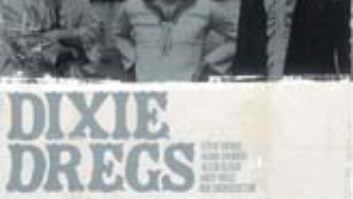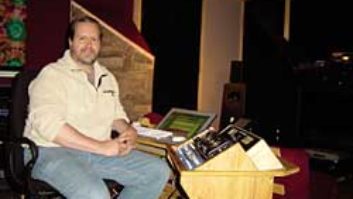
As if the N*Sync calendar wasn’t full enough — four albums infive years, a run of stadium tours and appearances at the Olympics, theSuper Bowl and World Cup — the band recently hit movie andtelevision screens across the world. Pop Odyssey, a DVD thatevolved into a European television broadcast, was recently released ina new chain of digital movie theaters. The project kept bandmember JCChasez and live sound mixer Tim Miller busy for nearly five months.
“I felt like we were doing the Fleetwood Mac thing without thedrugs, when it took them four years to do a record,” Millerjokes. “But it was always something that needed to be done, andwe couldn’t do it half-assed. One of the big reasons N*Sync issuccessful is because whenever they’ve had a chance to make the rightdecision or not make the right decision, they always make the rightdecision. They always do the right thing.”
For the Pop Odyssey DVD, television broadcast and digitaltheater release, that meant doing a lot of right things in a row. Afterrecording the band’s show at the Superdome in New Orleans (which waspart of the biggest tour in history with 91 trucks, 320 crew membersand 65 stadium shows), Miller and crew hopped over to Ideas Studios inFlorida to perform a handful of vocal overdubs and then sent all of thetapes (that included the original tracks on 1-inch and Tascam DA-88s,as well as the overdubs and a reference mix on Pro Tools) to SkywalkerSound. Once the material arrived at Skywalker, it was dumped into ProTools, which served as the playback source.
According to Leslie Ann Jones, Skywalker’s director of scoring,playback and mixing to Pro Tools seemed to make the most sense.“They really undertook an amazing amount of work,” shesays. “They had many different mixes to do, because theseparticular projects that they were on were going to be released on somany different formats. They ended up mixing mostly to Pro Tools; thatway, they could overlay audience and things like that. As their time onthe scoring stage went on, their needs became clear for all of thesedifferent formats.”
Miller and Chasez start the video-mixing sessions by getting a roughlayout of how the tracks come together. “We’ll start mixingsomething together, maybe the first two songs, to get a vibe. Then I’llsay, ‘All right, you sit with this for an hour, and then I’llcome in and get you and we’ll talk about it at thatpoint,’” Chasez explains. “Then we start tag-teamingit after the first two songs. That way, our ears stay fresh.”
The first mix that Miller and Chasez tackled in Skywalker’s scoringroom was the stereo mix for the European television broadcast, whichthey completed on a Neve VXS console. “After mixing live soundfor 20 years, it was really cool to have the feel of the Neve and do atrue stereo mix,” Miller recalls. “At the same time, youkind of forget — what with all of the keyboards and thesequencers — how fast the show moves. There’s a lot of moves, andthe desk was built in the ’70s without automation, so it was a lot ofwork.”
Yet the stereo mix laid the groundwork for the 5.1 DVD and digitaltheater mix, the part of the project that really excited the team.“It was a whole different thought in mixing, because when you’remixing in stereo, you’re doing more EQ, more effects, and [there’s] amuch different thought in layering your sound and how you’re spottingyour things into your mix and making it all fit,” Miller says.“It’s easier with N*Sync, because you hear it night after night.But then there are all of the little nuances of the music that you haveto make sure they sound out. That’s where JC becomes a huge part ofthis because JC is a real talent.”
The 5.1 mixes were performed at Skywalker’s Mix E room, which boastsa Euphonix System 5 console. To be sure, Chasez had fun with the extrachannels of audio. “You can do so many cool things,” hesays. “You can move effects — a lot of the explosions startrunning around your head. But the toughest part about it is theplacement in the 5.1 mix, because you want to take advantage of howwide it is; you don’t want to put everything in the front and just thecrowd noise in the back. So, we’ll keep the kick and snare in the frontstereo and then we’ll have the percussion coming from behind you. It’swild, yet it all blends.
“We mix it as if you are sitting in the crowd, so [there’s] abit of it all around you,” he continues. “That’s the onepart that gets tough to mix, and that’s what makes you take the extratime. But we feel like it’s worth it, because we want you to feel likeyou’re actually in the crowd, not just watching a DVD at home. We wantyou to feel like there’s three or four people standing in front of youmaking noise, as well.” There are certain pitfalls to thatapproach, Chasez allows, such as how to blend a screaming fan in thesame channel as a guitar. “You have to bring the guitar up alittle bit more, because the crowd noise will disguise and camouflagesome of the sounds,” he answers. “You have to mix aroundthat, as well. Usually the people that listen to the stuff that we mixfeel like they’re not just watching a concert, they feel like they’resitting in the concert; it’s more of a live experience.”
Once they left Skywalker, both Chasez and Miller believed that thesessions were done. Yet, there was a major problem with the digitaltheater release that Chasez didn’t realize until he heard it in atheater. “When we heard it in that room, I called up Tim on theway out and I said, ‘Dude, I don’t know what happened, but that’snot how it sounded when it left there,’” Chasez recalls.“‘It’s scaring the crap out of me. I know we didn’t dothis.’”
It turns out that the digital theaters had pulled the standardcrossovers and added their own audio systems. As Miller explains it,the bottom end was “mushy. They had taken the processing and thecrossovers out of the amp racks, so everything was just going fullbandwidth.” The easy solution was to go back to the stem mixes,cross over the subs and then clean up some of the aural clutter.“I had the audience too far forward in the 5.1 spectrum, so whatI did was move the audience stems more to the rear of the mix,”Miller says. “The combination of those two things just made itclick.”
The perfectionist in Chasez was relieved. “I was freaking out,because I know that there was no way in creation that I would have leftit sounding like that,” he says. “We came to find out itwas a technical problem, and when I heard the mix put back togetherthat fast, it sounded great.”
Even as the band are taking a bit of a sabbatical, the Miller-Chasezteam are heading back into the studio to mix the DVD based on N*Sync’slatest Celebrity tour.

Portraits of N*Sync onstage, by Steve Jennings:
N*Sync getting their groove on. Photo by Steve Jennings

N*Sync belts out a hit. Photo by Steve Jennings

Slowing it down onstage. Photo by Steve Jennings

The stage is prepared for N*Sync’s show. Photo by Steve Jennings

Mix Los Angeles editor Maureen Droney interviewed Leslie AnnJones, Skywalker Sound’s director of scoring, in August, 1999; theveteran engineer shared recording tips, career history and her favoritegear. Readinterview






